
Jean Léopold Nicolas Frédéric, Baron Cuvier, known as Georges Cuvier, was a French naturalist and zoologist, sometimes referred to as the "founding father of paleontology". Cuvier was a major figure in natural sciences research in the early 19th century and was instrumental in establishing the fields of comparative anatomy and paleontology through his work in comparing living animals with fossils.
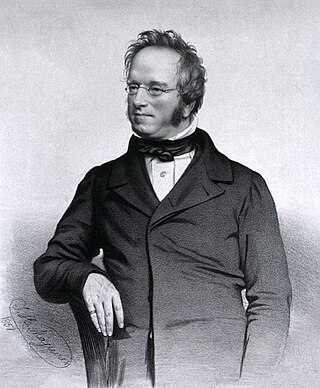
John Edward Gray, FRS was a British zoologist. He was the elder brother of zoologist George Robert Gray and son of the pharmacologist and botanist Samuel Frederick Gray (1766–1828). The standard author abbreviation J.E.Gray is used to indicate this person as the author when citing a botanical name. The same is used for a zoological name.

Edward Griffith (1790–1858) was a British naturalist and solicitor. He wrote General and Particular Descriptions of the Vertebrated Animals (1821) and translated Georges Cuvier's Règne animal, making considerable additions (1827–35).

Littoraria is a genus of sea snails, marine gastropod mollusks in the family Littorinidae, the winkles or periwinkles.
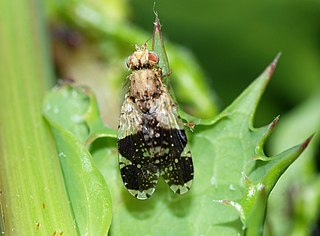
Tephritis is a genus of flies. It contains around 170 described species, making it the sixth largest genus in the family Tephritidae. Many more undescribed species are known from specimen collections. Tephritis occur throughout much of the world, but most are Palearctic. They can be found in a wide range of climate types, from hot semidesert to tundra. Most species inhabit the inflorescences of plants from several tribes in the family Asteraceae, and a few species cause galls to form.

Flabellina is a genus of sea slugs, specifically aeolid nudibranchs. These animals are marine gastropod molluscs in the family Flabellinidae.

Ptychobela griffithii is a species of sea snail, a marine gastropod mollusk in the family Pseudomelatomidae, the turrids.
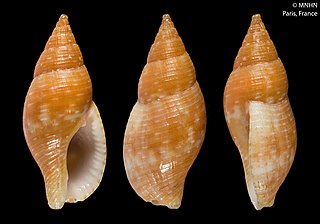
Pisania fasciculata is a species of sea snail, a marine gastropod mollusc in the family Pisaniidae, first described in 1846 by Lovell Augustus Reeve as Buccinum fasciculatum.

Pardalinops testudinaria, common name : the tortoise dove shell, is a species of sea snail, a marine gastropod mollusk in the family Columbellidae, the dove snails.
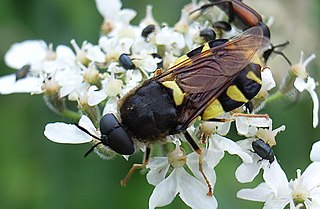
Stratiomys is a genus of flies in the family Stratiomyidae.

Teratodes, commonly known as hooded grasshoppers, is a genus of grasshopper native to India and Sri Lanka. It was established by the French entomologist Gaspard Auguste Brullé in 1835.

Panopinae is a subfamily of small-headed flies (Acroceridae). Their larvae are endoparasites of spiders in the infraorder Mygalomorphae.

Le Règne Animal is the most famous work of the French naturalist Georges Cuvier. It sets out to describe the natural structure of the whole of the animal kingdom based on comparative anatomy, and its natural history. Cuvier divided the animals into four embranchements, namely vertebrates, molluscs, articulated animals, and zoophytes.

Pelidnota kirbyi is a species of beetles of the family Scarabaeidae.

Cantharus elegans is a species of sea snails in the family Pisaniidae, the true whelks. It is found in Panama and Mexico.
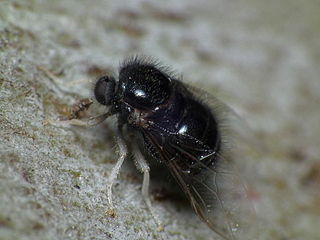
Pterodontia is a genus of small-headed flies. There are at least 20 described species in Pterodontia.
Pterodontia flavipes is a species of small-headed flies. Adult males are 5.5–10.5 mm in size, while adult females are 5–9 mm. The larvae are thought to enter their host spiders at the leg articulations. First instar larvae of the species have also been recorded attacking the mites Podothrombium and Abrolophus.
Eurycephalus is an invalid longhorn beetle generic name first published by the British zoologist John Edward Gray in 1831. It is now considered to be a junior objective synonym of the genus Tapeina established by the French entomologists Amédée Lepeletier and Jean Guillaume Audinet-Serville in 1828. Several other organisms were also named Eurycephalus by other zoologists that have since been invalidated. They are listed below with their current accepted name:
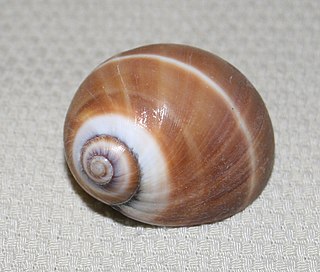
Polinices bifasciatus, or two-banded moon snail, is a species of gastropod mollusc. The animal was first described to science in a work authored by English biologists Edward Griffith and Edward Pidgeon. This was a multi-volume translation of George Cuvier's, Le Règne Animal (1830). The Griffith and Pidgeon work went beyond translation and added a supplement that included the description of Polinices bifasciatus. The description of Polinices bifasciatus is attributed to John Edward Gray. It reads, in its entirety, "Pale brown, with two narrow bands".
Ancala is a genus of horse flies in the family Tabanidae.
















